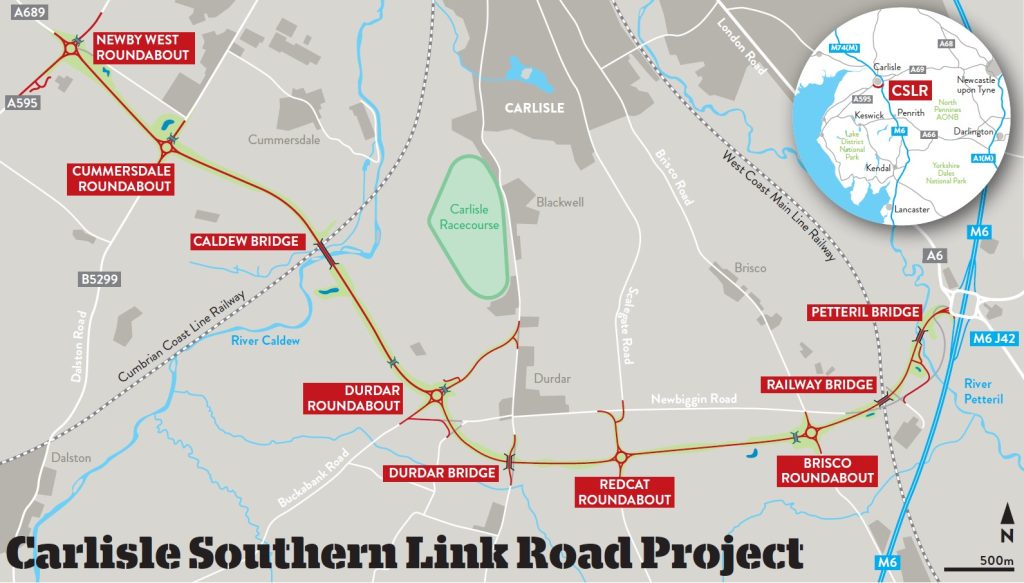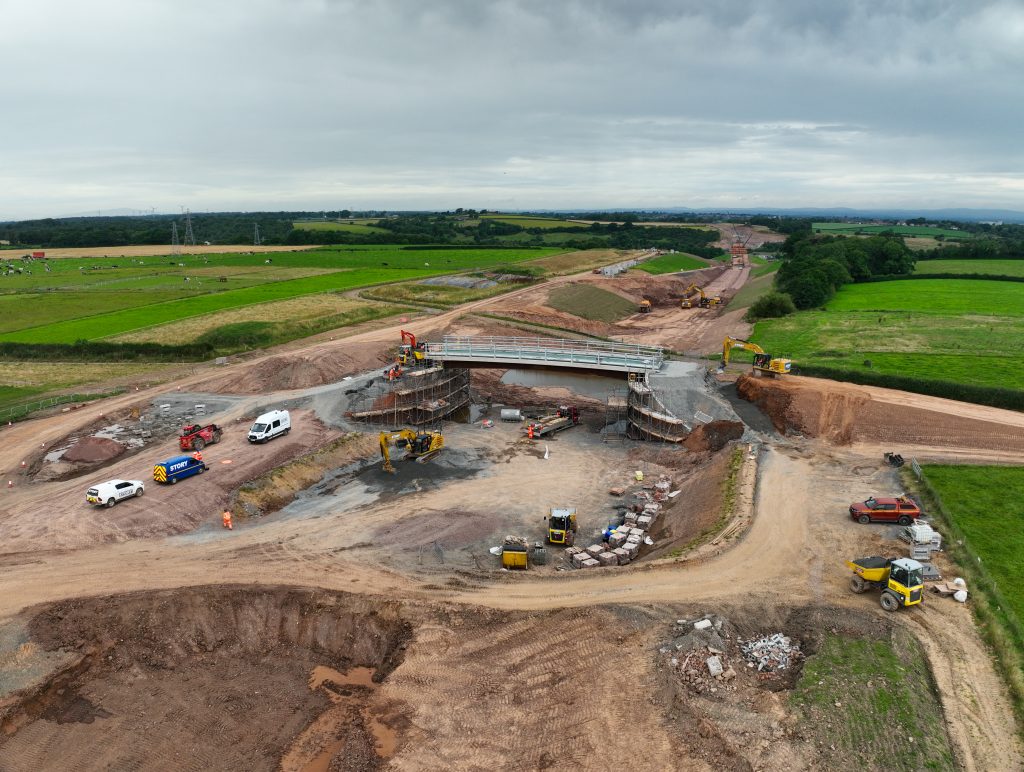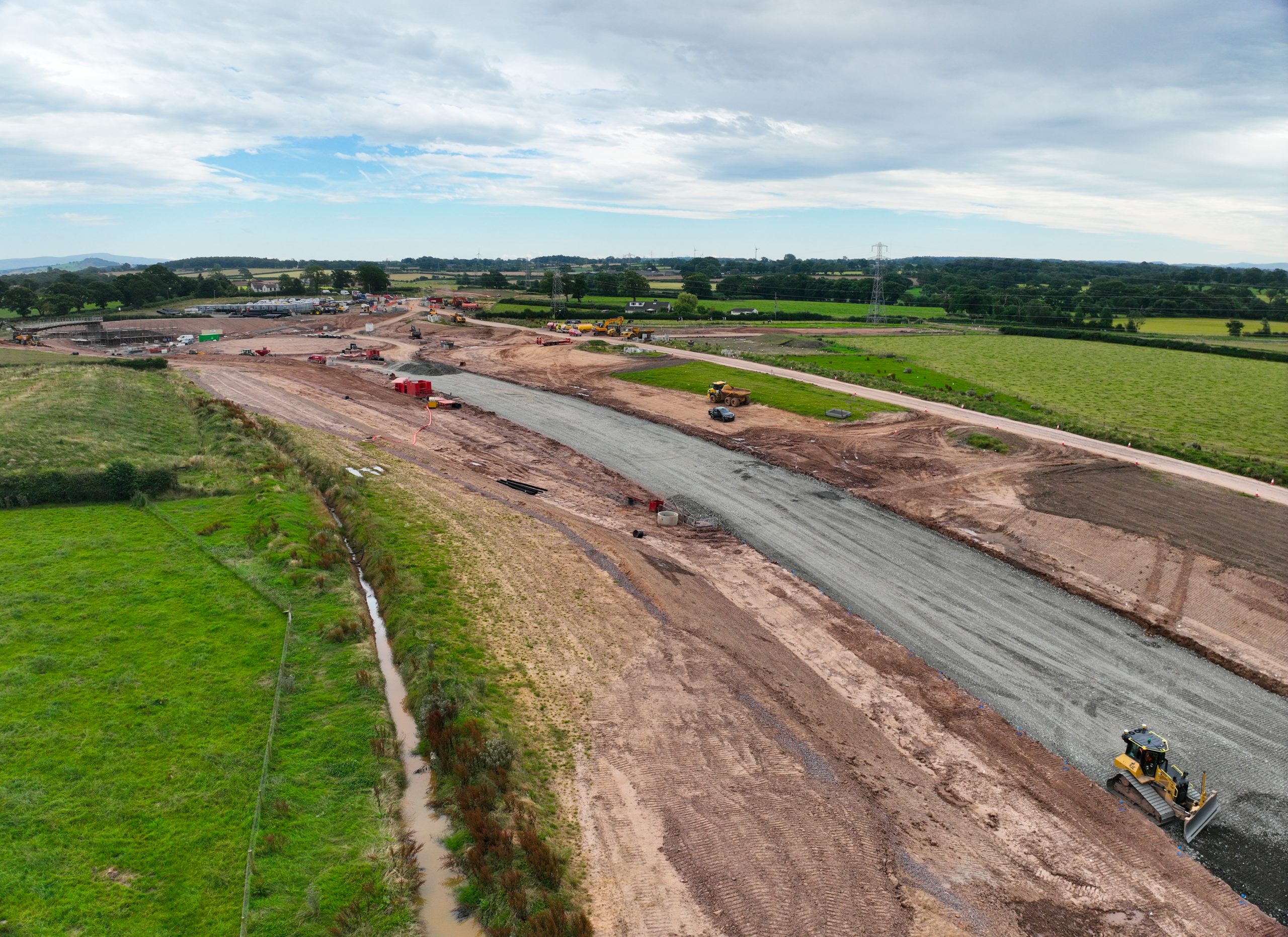Plans to build a garden village on the edge of Carlisle will be given a significant boost when the city’s new southern link road is completed next year.
Road schemes can take a long time to reach construction, due to the need for funding, public consultation, stakeholder engagement, habitat surveys and so on. But when the 8km long single carriageway Carlisle Southern Link Road is completed in late autumn next year, it will be half a century since it was first mooted.
Much has changed since then, including the political landscape of the area. In 2023, just as the construction contract was finally being awarded, unitary authority Cumberland Council was established. This council took over services that were previously delivered by Carlisle City Council, Cumbria County Council and two borough councils.
What’s more, the need for the scheme has since changed from serving as a bypass of the city centre to being the key that will unlock plans to establish a new residential neighbourhood. As Cumberland Council project director Alan Bingham explains, the scheme was one of two options put forward in the 1970s to eliminate through traffic from the centre of Carlisle and provide a direct link from the M6 motorway to the Cumbrian coast.
Since that time, the need for new housing has increased. Cumberland Council has ambitious plans to build St Cuthbert’s Garden Village, comprising more than 10,000 homes, on farmland south of the city centre. The Carlisle Southern Link Road is a critical part of making that happen. Planning for St Cuthbert’s Garden Village began in 2016, when it was identified as an area for growth in the Carlisle District Local Plan. The masterplan was published in 2020.
The housing ministry would never normally fund a road project to this extent
In transport terms, it will certainly improve east to west connectivity by linking the radial highways south of the city – the A595 and the A6. It will also add much-needed crossings of two railway lines and two rivers. But just as important are the facilities for active travel that the scheme includes.
There are four bridges planned for cyclists and pedestrians that will provide grade-separated crossings at junctions along the length of the route. These bridges will also facilitate connections into the active travel infrastructure that is part of the village masterplan. The scheme additionally includes five roundabouts and five road bridges.
The Ministry of Housing, Communities & Local Government – formerly the Department for Levelling Up, Housing & Communities – has committed £212M towards the link road. Cumberland Council has allocated £13.4M, including £3.4M from the future sale of council-owned land for the development.
“The housing ministry would never normally fund a road project to this extent,” explains Bingham; “the driver really is the garden village, and this road will move it firmly into the delivery stage.”

Risk reduction
But even with funding and approvals secured, getting to construction was complex, he adds. “We appointed Morgan Sindall to run through a two-stage approach – stage one was surveys, detailed design and target cost, and stage two would have been the award of the contract and construction. But we got caught up in Covid, the Ukraine war and the rest of it, the prices shot through the roof and the scheme became unaffordable.”
A break clause allowed the contract with Morgan Sindall to be terminated amicably and gave the council breathing space to try and remove some of the risk from the scheme. This makes it more attractive to contractors, with the eventual intention of bringing the price down.
“We carried out site clearance and some high-risk service diversions, including a high-pressure gas main,” explains Bingham. “Alongside that, we completed some elements of the design as far as we were able to.”
Once bidding reopened, there was a concerted push by the council to get construction moving as quickly as possible, to ensure they would be able to take full advantage of the earthwork seasons. Consultant WSP had worked on the design for Morgan Sindall and was retained by the successful bidder, Galliford Try.
Galliford Try project manager Phil Robinson explains that a lot of preparation was carried out during the tender process in anticipation of winning the bid: “We had a mobilisation plan so we could get to site quickly if we were successful. When the decision was made, Cumberland acted quickly in terms of signing contracts. Within three months, we went from half a dozen people working on it up to about 80, and awarded about £70M of work packages.”
Being able to use the full earthworks season was critical, Robinson says, with the £136M contract requiring around 800,000t of bulk excavation: “We’ve essentially got two earthwork seasons to get this job done – we’ll have a bit more time next season but most of it has to be done in the first two.” But the weather has not been kind and completion has been pushed back by several months, from summer to ‘late autumn’.
“The nature of the clay ground we are working on means that if you get more than a couple of days of rain you have to pull off, so as to avoid damaging it,” explains Robinson. “We’ve had some challenges around quality of the material and we’re doing a lot of onsite lime treatment to get it up to the appropriate quality for reuse.”
There is a big push now to get it moving, so we can make use of the infrastructure; the council very much wants to up the gear on this
Water management
Water is a recurrent theme on the project, unsurprisingly given that Carlisle city is historically prone to flooding. Both the Cardew and Petteril rivers are tributaries to the River Eden, which flows through the city centre. These rivers rise in the Lake District, to the south of Carlisle, and will be crossed by the link road on new bridges.
The water management features included in the scheme are aimed at attenuating runoff from the new highway and slowing down the discharge. This includes eight new ponds to help reduce the risk of flooding downriver, 44km of drainage across the scheme, as well as a new flood relief culvert under the embankment of the Petteril Bridge.
Temporary ponds have also been built to ensure that the construction phase doesn’t increase the risk of flooding, with ‘silt-busters’ to remove suspended solids from runoff if it must be discharged to the waterways before having time to settle. The retained water is also intended for use as a dust suppression measure, which hasn’t been necessary yet, says Robinson wryly.
More to the point, there is a flood response plan that had to be brought into play earlier in the year, he recalls: “In June we had a flood event where there was a lot of rain falling in the corridor between the two rivers, and it was coming straight at us in Carlisle. We had to put our plan into action, it was a long night making sure pumps were in place on site, running properly and so on.”
Making connections
With so many features on the road, there’s a lot to think about in terms of construction logistics. “It’s primarily greenfield land and the job is split logistically at the Caldew,” says Robinson. “One of the issues in Carlisle is the limited number of river crossings; to get from one side of the Caldew to the other you’ve got to either drive back into the city, or go quite a way south. We’re using a Bailey bridge to get us into the area between the river and the railway, to build a pier, but we can’t install one to maintain a haul road because there’s too much level difference between the two sides.”
But there are favourable aspects too: “Because it is facilitating the garden village, the new highway has a lot more connectivity to the existing roads than a regular bypass would; we’ve got those access points for construction.”
The Caldew Bridge is the largest on the scheme; a 170m long, three-span structure with weathering steel beams up to 3.8m deep, to carry the highway across the River Caldew and its floodplain, and the Cumbrian Coastline Railway.

The Brisco Footbridge is one of the project’s four bridges for active travel
WSP BIM manager Richard Godden says a lot of work was done in trying to develop a visual aesthetic for the structures that would work throughout the scheme. Weathering steel and sandstone cladding was chosen to suit the natural environment of the area.
“Early in the project we did an options report for the structures, in particular looking at the footbridges to see whether we could create something more iconic. We settled on this aesthetic treatment as it doesn’t require a fully architectural design that would push the cost up,” he says. A lot of work also went into rationalising the detailing across the four footbridges and the accommodation bridge.
When the weather allows, progress on the scheme has been good, says Robinson: “We’ve already completed a lot of bridge beam lifts, and the flood culvert on the Petteril Bridge was a major piece of construction and a milestone that had to be hit early in the programme.”
The culvert consists of four, 90m long, 1.2m-diameter pipes with a reinforced concrete structure built around them, within a 12m embankment, the highest on the scheme. The key was to get earthworks done by the end of the first season to allow consolidation of the embankment through the winter period. This demanded tight scheduling between the drainage and earthworks contractors to ensure they were working as efficiently as possible.
The next major milestone is in October, says Robinson, when beams for the Caldew Bridge will be delivered in preparation for lifting into place over the Christmas period – a process that requires crane access from both sides of the river. Two of the spans will be erected from one side, and one span from the other. The crane will need to be dismantled and rebuilt for it to move from one side to the other. Beams will be lifted in six braced pairs, weighing up to 165t per pair.
Planting will start shortly; in total, 270,000 plants, including around 45,000 aquatic plants for the ponds, will be brought in to recreate and add to the habitats that have been lost. The ecological measures also include recreating holts on the rivers for the local otter population.
Meanwhile, Bingham says that the council is focused on establishing an appropriate delivery vehicle for the garden village, with details of the structure and governance expected to be made public later this year. “There is a big push now to get it moving, so we can make use of the infrastructure; the council very much wants to up the gear on this,” he says.
Like what you've read? To receive New Civil Engineer's daily and weekly newsletters click here.
 New Civil Engineer Civil engineering and construction news and jobs from New Civil Engineer
New Civil Engineer Civil engineering and construction news and jobs from New Civil Engineer




Have your say
or a new account to join the discussion.